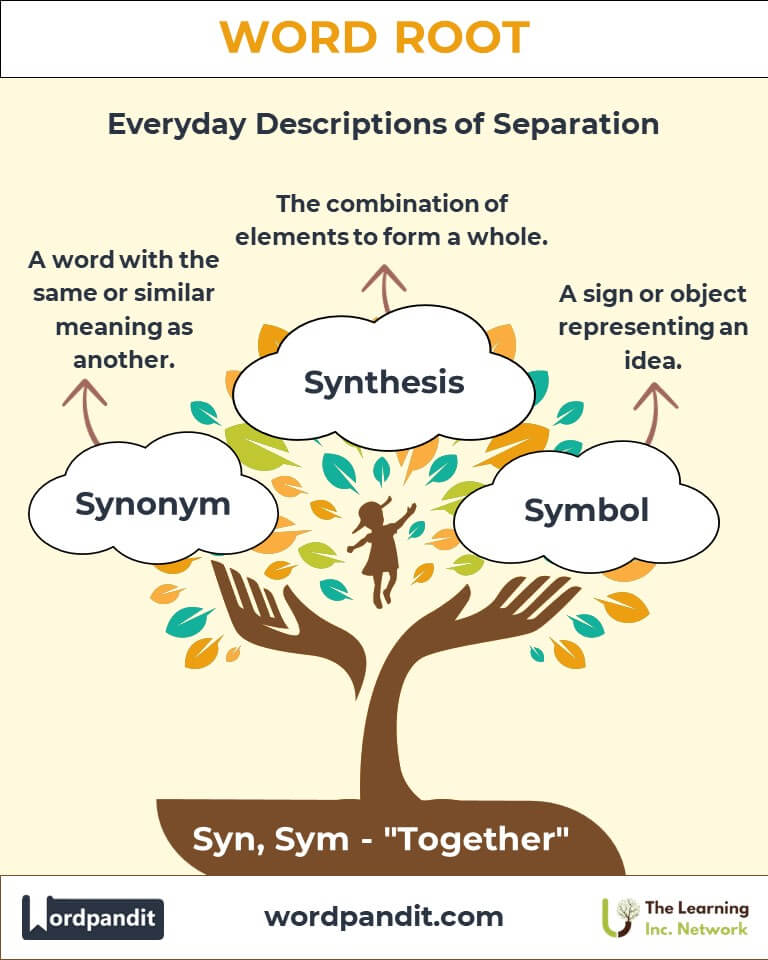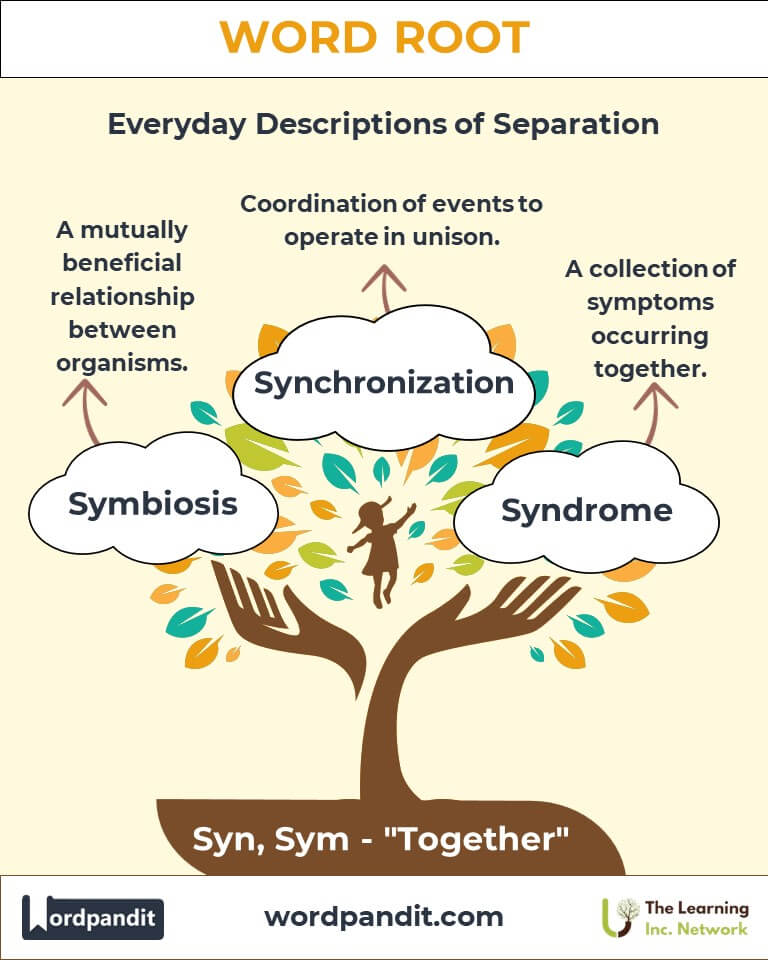Syn, Sym: The Roots of Togetherness in Language and Life
Explore the unifying power of the word roots "syn" and "sym," meaning "together." These Greek roots form the foundation of words that emphasize unity, collaboration, and synthesis across fields, from science to art.

Table of Contents
- Introduction: The Essence of Syn and Sym
- Etymology and Historical Journey
- Mnemonic: Unlocking the Power of Syn and Sym
- Common Syn and Sym-Related Terms
- Syn and Sym Through Time
- Syn and Sym in Specialized Fields
- Illustrative Story: Syn and Sym in Action
- Cultural Significance of Syn and Sym
- The Syn and Sym Family Tree
- FAQs About the Syn and Sym Word Root
- Test Your Knowledge: Syn and Sym Word Root Quiz
- Conclusion: The Living Legacy of Syn and Sym
1. Introduction: The Essence of Syn and Sym
When people collaborate to solve a problem, their ideas merge in synthesis. When a flag represents a nation, it serves as a symbol of unity. These examples highlight the influence of the word roots "syn" and "sym," derived from the Greek word syn, meaning "together" or "with." These roots are woven into words that signify harmony, connection, and cohesion, resonating across disciplines and cultures.

2. Etymology and Historical Journey
The roots "syn" and "sym" originate from the Greek syn, meaning "with" or "together." Over time, these roots merged into Latin and later English, maintaining their original sense of unity. In ancient philosophy, they described cosmic harmony, and in medieval scholarship, they informed ideas about synthesis in logic and art. Today, they connect ideas in linguistics, science, and technology.
3. Mnemonic: Unlocking the Power of Syn and Sym
Imagine a symphony orchestra, where each musician plays a different instrument, yet together they create a harmonious piece of music. This image captures the essence of "syn" and "sym"—working together to form something greater than the sum of its parts.
Mnemonic Device:
"Syn and Sym unite like a symphony—together in harmony!"
4. Common Syn and Sym-Related Terms
- Synthesis (sin-thuh-sis):
Definition: Combining elements to form a whole.
Example: "The scientist achieved a breakthrough through the synthesis of two theories." - Symbol (sim-bul):
Definition: An object or sign representing an idea.
Example: "The dove is a symbol of peace." - Symbiosis (sim-bai-oh-sis):
Definition: A mutually beneficial relationship between organisms.
Example: "Corals and algae have a symbiosis essential for marine ecosystems." - Synonym (sin-uh-nim):
Definition: A word with the same or similar meaning as another word.
Example: "Happy and joyful are synonyms." - Symmetry (sim-uh-tree):
Definition: Balanced proportions or harmony in design.
Example: "The architecture of the palace is known for its perfect symmetry."
5. Syn and Sym Through Time
- Ancient Greece: Philosophers like Pythagoras emphasized harmony, using "syn" in mathematical and cosmic contexts.
- Renaissance: "Synthesis" became central in scientific and artistic breakthroughs, symbolizing integration.
- Modern Era: Words like "symphony" and "synchronization" evolved to describe complex systems working in unison.
6. Syn and Sym in Specialized Fields
Medicine
Syndrome: A collection of symptoms occurring together.
Example: "Down syndrome is caused by a chromosomal condition."
Biology
Symbiosis: Organisms living in close association for mutual benefit.
Example: "Bees and flowers exhibit symbiosis."
Technology
Synchronization: Coordination of events to operate in unison.
Example: "The devices were synchronized to share data seamlessly."
Linguistics
Synonym: Words with similar meanings enrich language.
Example: "Writers use synonyms for variety and nuance."
7. Illustrative Story: Syn and Sym in Action
At a bustling tech company, a project manager orchestrated a synthesis of ideas from a diverse team to develop groundbreaking software. Their success symbolized the power of collaboration, akin to a symphony where every note plays a part in creating harmony. This story reflects how "syn" and "sym" drive innovation through unity.
8. Cultural Significance of Syn and Sym
From the universal symbol of the Olympic rings representing global unity to the biological symbiosis that sustains life, the roots "syn" and "sym" permeate cultural narratives. They underscore the importance of cooperation and interdependence in building strong societies and ecosystems.

9. The Syn and Sym Family Tree
- Co- (Latin: "together"):
- Cooperate: To work together for a common goal.
- Con- (Latin: "with"):
- Connect: To join or link together.
- Pan- (Greek: "all"):
- Panacea: A remedy for all ills, emphasizing collective healing.

10. FAQs About " Syn " and " Sym "
Q: What do "syn" and "sym" mean?
A: The roots "syn" and "sym" both mean "together" or "with." They come from the Greek word "syn," which describes unification or association. These roots adapt based on the sounds of the words they precede, such as "synthesis" (combining elements) or "symbiosis" (a mutual relationship).
Q: What is the difference between "syn" and "sym"?
A: Both prefixes mean the same, but their spelling changes depending on the first letter of the base word they join. "Syn" is used before most letters, such as in "synthesis." "Sym" is used when the base word starts with "b," "m," or "p," creating smoother pronunciation, as in "symmetry" or "symbol."
Q: What is synthesis?
A: Synthesis refers to the process of combining different elements, ideas, or components into a unified whole. It can be applied in various contexts, such as science (combining chemicals to create a compound), writing (synthesizing ideas into an argument), or art (blending techniques into a masterpiece).
Q: What is symbiosis?
A: Symbiosis is a biological term describing a close, mutually beneficial relationship between two organisms. For example, bees and flowers depend on each other—bees get nectar, and flowers get pollinated. This term is often extended metaphorically to describe cooperative relationships in human life.
Q: What does a symbol represent?
A: A symbol is a sign, object, or image that represents an idea, concept, or relationship. For example, a heart is a symbol of love, and a flag is a symbol of a nation. Symbols often carry deeper meanings tied to cultural or societal contexts.
11. Test Your Knowledge: " Syn " and " Sym " Mastery Quiz
1. What do the roots "syn" and "sym" mean?
2. Which word describes balance or harmony?
3. What is symbiosis?
4. What is the meaning of synthesis?
5. Which word refers to coordination in timing?
12. Conclusion: The Living Legacy of Syn and Sym
The roots "syn" and "sym" remind us of the power of unity, collaboration, and harmony. From ancient philosophies to modern technologies, their influence persists in shaping how we understand and interact with the world. Embrace these roots in your vocabulary and let them inspire teamwork and togetherness in all aspects of life.












